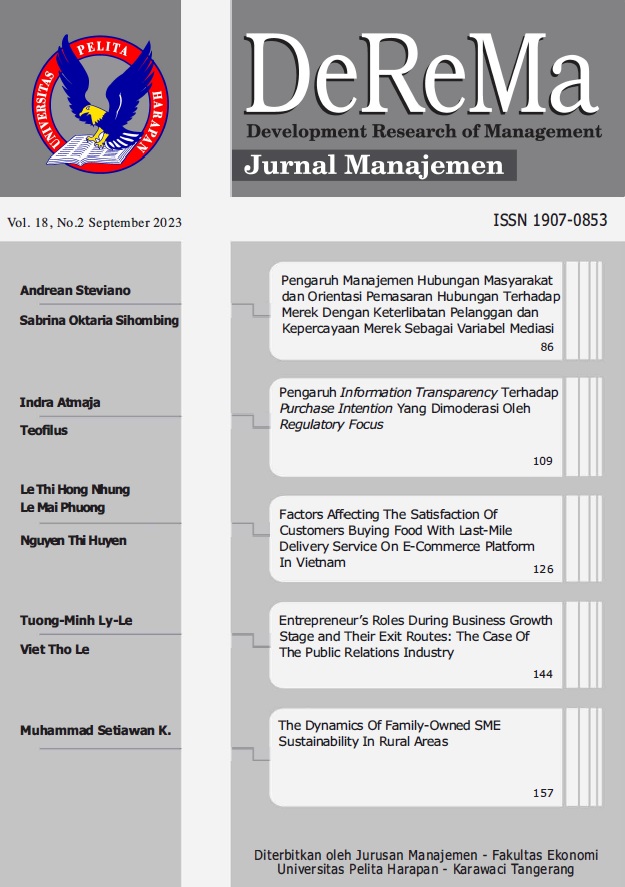ENTREPRENEUR’S ROLES DURING BUSINESS GROWTH STAGE AND THEIR EXIT ROUTES: THE CASE OF THE PUBLIC RELATIONS INDUSTRY [PERAN PENGUSAHA DALAM TAHAP PERTUMBUHAN BISNIS DAN RUTE KELUAR DARI BISNIS TERSEBUT: KASUS INDUSTRI PUBLIC RELATIONS]
DOI:
https://doi.org/10.19166/derema.v18i2.7294Keywords:
entrepreneurship, business growth, exit routes, Vietnam, SMEsAbstract
This research article aims to examine the entrepreneur’s roles during the business growth stage and their exit routes, with a focus on the public relations industry in Vietnam. The findings highlight the transition of entrepreneurs from hands-on involvement in all aspects of the business to assuming strategic roles during the growth stage. Founders play a crucial role in setting the company’s vision, establishing a solid organizational culture, and fostering innovation. The decision of whether to maintain control or delegate management responsibilities is critical, with some entrepreneurs choosing to retain control due to their emotional attachment, while others recognize the need to delegate to professional managers.
Abstrak dalam Bahasa Indonesia. Artikel penelitian ini bertujuan untuk mengkaji peran pengusaha selama tahap pertumbuhan bisnis dan rute keluarnya, dengan fokus pada industri hubungan masyarakat di Vietnam. Temuan menyoroti transisi pengusaha dari keterlibatan langsung dalam semua aspek bisnis untuk mengambil peran strategis selama tahap pertumbuhan. Pendiri memainkan peran penting dalam menetapkan visi perusahaan, membangun budaya organisasi yang solid, dan mendorong inovasi. Keputusan apakah akan mempertahankan kendali atau mendelegasikan tanggung jawab manajemen sangat penting, dengan beberapa pengusaha memilih untuk mempertahankan kendali karena keterikatan emosional mereka, sementara yang lain menyadari kebutuhan untuk mendelegasikan kepada manajer profesional.
References
Abecassis”Moedas, C., BenMahmoud”Jouini, S., Manceau, D., & Pereira, J. (2021). Imprinting of founders’ entrepreneurial motivations on enterprises’ practices and processes: The context of creative industries. Creativity and Innovation Management, 30(1), 182-197. https://doi.org/10.1111/caim.12421
Bartlett, C. A., & Ghoshal, S. (1994). Changing the role of top management: Beyond strategy to purpose. Harvard Business Review, 72(6), 79-88.
Børke, M., & Trossmark, P. (2016). Growing pains: A study of SME growth [Master’s thesis]. Norwegian University of Science and Technology, Oslo, Norway.
Cartwright, S., & Cooper, C. L. (1996). Managing mergers, acquisitions, and strategic alliances: Integrating people and cultures. Routledge. https://doi.org/10.1016/B978-0-7506-2341-4.50003-5
Dibrell, C., Marshall, D., Palar, J., & Gentry, R. (2019). New director selection during growth in family-influenced and lone founder firms: An identity fit perspective”. Journal of Business Research, 101, 1-11.
Dillen, Y., Laveren, E., Martens, R., De Vocht, S., & Van Imschoot, E. (2019). From “manager” to “strategist”: An examination of the evolving role of persistent high-growth entrepreneurs. International Journal of Entrepreneurial Behavior and Research, 25(1), 2-28. https://doi.org/10.1016/j.jbusres.2019.04.005
Glaser, B., & Strauss, A. S. (1967). The discovery of grounded theory. Aldine.
Hendricks, B., Howell, T., & Bingham, C. (2019). How much do top management teams matter in founder-led firms?. Strategic Management Journal, 40, 959-986. https://doi.org/10.1002/smj.3006
Ly-Le, T. M. (2021). Small business entrepreneurship in Vietnam: The case of the public relations industry. DeReMa (Development Research of Management): Jurnal Manajemen, 16(2), 145-157. https://doi.org/10.19166/derema.v16i2.3760
Ly-Le, T. M. (2023). The entrepreneurial journey in Vietnam’s public relations industry: The motivation, the role and the challenges. Journal of Management Development, 42(1), 76-90. https://doi.org/10.1108/JMD-04-2022-0101
Masurel, E. (2019). The entrepreneurial dilemma in the life cycle of the small firm: How the firm and the entrepreneur change during the life cycle of the firm, or how they should change. Emerald Publishing. https://doi.org/10.1108/9781789733150
Mirvis, P. H., & Marks, M. L. (1992). The human side of merger planning: Assessing and analyzing “fit”. Human Resource Planning, 15(3), 69-92.
Mitchelmore, S., & Rowley, J. (2010). Entrepreneurial competencies: a literature review and development agenda. International Journal of Entrepreneurial Behavior and Research, 16(2), 92-111. https://doi.org/10.1108/13552551011026995
Oliver, D., & Vough, H. C. (2020). Practicing identity in emergent firms: How practices shape founders’ organizational identity claims. Strategic Organization, 18(1), 75-105. https://doi.org/10.1177/1476127019863642
Oviatt, B. M., & McDougall, P. P. (1995). Global start-ups: Entrepreneurs on a worldwide stage. Academy of Management Perspectives, 9(2), 30-43. https://doi.org/10.5465/ame.1995.9506273269
Picken, J. (2017). From founder to CEO: An entrepreneur’s roadmap. Business Horizons, 60, 7-14. https://doi.org/10.1016/j.bushor.2016.09.004
Pless, N., & Maak, T. (2004). Building an inclusive diversity culture: Principles, processes and practice. Journal of Business Ethics, 54, 129-147. https://doi.org/10.1007/s10551-004-9465-8
Scott, M., & Bruce, R. (1987). Five stages of growth in small business. Long Range Planning, 20(3), 45-52. https://doi.org/10.1016/0024-6301(87)90071-9
Shah, S. F. H., Nazir, T., Zaman, K., & Shabir, M. (2013). Factors affecting the growth of enterprises: A survey of the literature from the perspective of small-and medium-sized enterprises. Journal of Enterprise Transformation, 3(2), 53-75. https://doi.org/10.1080/19488289.2011.650282
Shepherd, D. A., & Patzelt, H. (2021). Entrepreneurial strategy: Starting, managing, and scaling new ventures. Springer Nature. https://doi.org/10.1007/978-3-030-78935-0
Straub, T. (2007). Reasons for frequent failure in mergers and acquisitions: A comprehensive analysis. Springer Science and Business Media. https://doi.org/10.1007/978-3-8350-9637-0
Walter, G. A., & Barney, J. B. (1990). Research notes and communications management objectives in mergers and acquisitions. Strategic Management Journal, 11(1), 79-86. https://doi.org/10.1002/smj.4250110107
Wang, C., Walker, E., & Redmond, J. (2007). Explaining the lack of strategic planning in SMEs: The importance of owner motivation. International Journal of Organisational Behaviour, 12(1), 1-16.
Wennberg, K., & DeTienne, D. R. (2014). What do we really mean when we talk about ”˜exit’? A critical review of research on entrepreneurial exit. International Small Business Journal, 32(1), 4-16. https://doi.org/10.1177/0266242613517126
Wiklund, J., Davidsson, P., & Delmar, F. (2003). What do they think and feel about growth? An expectancy-value approach to small business managers’ attitudes toward growth. Entrepreneurship Theory and Practice, 27(3), 247-270. https://doi.org/10.1111/1540-8520.00014
Downloads
Published
Issue
Section
License
Authors who publish with this journal agree to the following terms:
1) Authors retain copyright and grant the journal right of first publication with the work simultaneously licensed under a Creative Commons Attribution License (CC-BY-SA 4.0) that allows others to share the work with an acknowledgement of the work's authorship and initial publication in this journal.
2) Authors are able to enter into separate, additional contractual arrangements for the non-exclusive distribution of the journal's published version of the work (e.g., post it to an institutional repository or publish it in a book), with an acknowledgement of its initial publication in this journal.
3) Authors are permitted and encouraged to post their work online (e.g., in institutional repositories or on their website). The final published PDF should be used and bibliographic details that credit the publication in this journal should be included.





